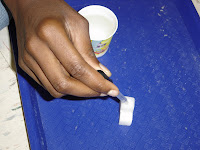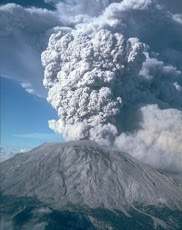Dear Lowry 4th Graders and Parents,
We wanted to take a moment and introduce you all to our next Science Unit. 4th graders in Mrs. K-F's and Ms Bush's classroom will be exploring concepts of weathering, erosion, and rock recycling. They will learn that weathering, primarily from the effects of wind and water, causes the breakdown of earth materials. In contrast, erosion refers to the transport of these weathered materials. The concepts of weathering and erosion can at times be difficult to simulate in the classroom environment. In this way, students will also be exploring how scientists use scientific models to help them learn about the world.
Over the next few weeks our Science classroom will be filled with exciting hands-on and minds-on activities. Including weathering a sugar cube tombstone, working with a stream table, and of course we will not be ignoring catastrophic events such as floods and volcanoes.
We hope that both you and your student are excited about what will be taking place during Science. Look back here frequently for updates on activities and investigations done in our classroom.
Sincerely,
Ms Bush and Mrs. K-F
Water - A Weathering Agent
Over the past couple of weeks the students have been investigating the concept of weathering. All rocks weather when they are exposed to Earth's atmosphere. However, different types of rock weather at different rates and most visible effects seen from weathering occurs very slowly. Due to these circumstances the students needed an easier way to study the effects of weathering. Therefore the students used scientific models to simulate the effects of weathering in the classroom and at a much more rapid rate. 
The students put on their "Scientific Slueth" hats and built a "temporary tombstone" out of sugar cubes to help them investigate how a rock that just sits in a cemetery can crack, break, and wear down when exposed to rain.


The students put on their "Scientific Slueth" hats and built a "temporary tombstone" out of sugar cubes to help them investigate how a rock that just sits in a cemetery can crack, break, and wear down when exposed to rain.
The kids test how a sugar cube tombstone can be weathered by water.

Wind and Sand Weather Too!
 After exploring how rocks weather in the rain, students next spent some time investigating how blowing sand changes rocks' shapes. The purpose was to provide an opportunity for students to explore the action of wind as an agent that weathers, or breaks down rocks.
After exploring how rocks weather in the rain, students next spent some time investigating how blowing sand changes rocks' shapes. The purpose was to provide an opportunity for students to explore the action of wind as an agent that weathers, or breaks down rocks.In order to explore how wind serves as an agent of weathering. The students used "sandblasters" or enclosed environments where they could witness the movement of sand via wind. They first observed that sand moves differently depending upon how hard the wind is blowing. Next they became aware that rock can be broken down, or weathered, by particles carried by the wind. Students used their sandblasters to test the effects of blowing sand on a sugar cube tombstone.



The students test how wind and sand weather a sugar cube tombstone.
Los estudiantes probar cómo el viento y arena tiempo una lápida de cubo de azúcar.
The Great Earth Mover
During the first few lessons, students learned that rocks break down. All of the processes that break rock in to smaller pieces is known as weathering. Weathering is one way in which the Earth changes. Erosion, or the movement of earth materials to a new location is another way in which the Earth changes.
To begin to formulate the student's understanding of erosion, we closely examined one of the Earth's greatest movers-water. Students began their investigation into the "Great Earth Mover" by first making a flat model of the earth and observing what happens to water on the surface of the Earth. Students then changed that model so that the water moved downhill. In doing so they learned that water traveled from high places or elevations to low places or lower elev ations.
ations.

The students built models to help them begin to understand how water moves on the Earth's surface.
To begin to formulate the student's understanding of erosion, we closely examined one of the Earth's greatest movers-water. Students began their investigation into the "Great Earth Mover" by first making a flat model of the earth and observing what happens to water on the surface of the Earth. Students then changed that model so that the water moved downhill. In doing so they learned that water traveled from high places or elevations to low places or lower elev
 ations.
ations.
The students built models to help them begin to understand how water moves on the Earth's surface.
Los estudiantes construyeron modelos para ayudarles a comenzar a entender cómo el agua se mueve sobre la superficie de la tierra.
Stream Studies


Next, the students observed and described the flow of water through a stream model. They made changes to their stream models, such as building damns, and observed how those changes effect the flow of water on Earth. The students built "Tiny Towns" and observed what would happen to the "citizens" if and when a flood occurred. Throughout these explorations the students were able to describe the movements of earth materials in their models as erosion and the landing places of earth materials as deposition. They experienced in a concrete, hands-on way why scientists use models to help them learn about real things.
The students built stream models and observed how water moves Earth materials.
The students built stream models and observed how water moves Earth materials.
Los estudiantes construyeron modelos de secuencia y observaron cómo el agua mueve materiales de tierra.

Stream Explanations
The role of water in changing the Earth's surface was a fundamental conceptual outcome for this unit. As we continued our exploration into stream studies, the students were able to investigate how the speed of water affects and changes earth materials. The students discovered that water flows faster when it is at a steeper angle. Which in turn affects the amount of soil, rock and sand that that stream can carry. The students explored this concept by measuring the travel time of objects in fast (steep) and slow (level) water systems. From this experience they constructed that quickly moving water erodes and deposits earth material, thus changing the surface of the Earth.
Volcanoes and Earthquakes

How do volcanoes and earthquakes change Earth's surface?
In their quest to continue to learn how and why the surface of the Earth changes, the students investigated the above question. Throughout this unit the students have been learning that the Earth's surface is constantly changing. Most of the changes occur through slow processes such as weathering, erosion, and deposition from water and wind - most, but not all!
The students observed a classroom demonstration of a volcanic eruption and soon recognized that Earth's surface can change rapidly because of phenomena such volcanoes and earthquakes. They learned that the slow processes of weathering, erosion, and deposition can also occur quickly due to a catastrophic earthly event They then discussed the speed at which the Earth's surface changed from the volcanic eruption and compared that information with that they had previously observed with only wind and water.
 The picture above is similar to one that the student's observed in the classroom. It demonstrated the power of a volcanic eruption and how quickly the surface of the Earth can change.
The picture above is similar to one that the student's observed in the classroom. It demonstrated the power of a volcanic eruption and how quickly the surface of the Earth can change.
Subscribe to:
Comments (Atom)




